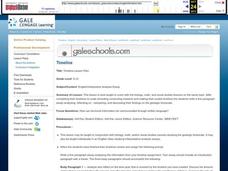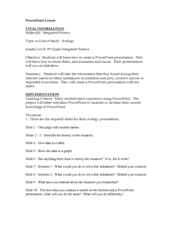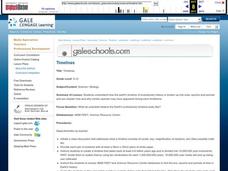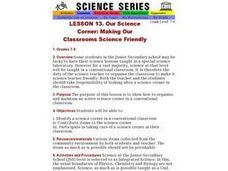Curated OER
Where Do Birds Live? Cavity Nesters of the Watsonville Wetlands
Students compare and contrast primary and secondary cavity nesters. For this life science lesson, students explore the different types of nests that birds make. They play a team game to apply what they learned.
Curated OER
The African and the Pequot in Colonial America
Students determine that the lands the English settled on were owned and inhabited by 70,000 Indians. They consider that the London Company sold land charters to the English, which gave them illegal title to lndian land and that the...
Curated OER
Botanical Discoveries
Sixth graders study the chronology of major events of the Lewis and Clark Expedition. They use primary and secondary resources to obtain information about the plants which were identified by Lewis and Clark.
Curated OER
Immunization
students study contents and origin of vaccines. They should understand the relationship of the vaccine to primary and secondary immune responses of the body. They work in pairs and share the responsibility of writing responses to...
Curated OER
Disease Lesson Plan
High schoolers research the bubonic plague including disease facts, the time frame of outbreaks and the impact it had on society. They examine the work of Edgar Allen Poe and write an essay explaining why the plague was a subject of...
Curated OER
Timeline
Students develop a timeline that depicts geologic development and the history of life. They write an interpretive analysis essay that discusses and reflects on their observations.
Curated OER
Ecology
Students personify ecology vocabulary and write a one-act play using their knowledge of ecology as the basis for characters, conflict, setting and plot.
Curated OER
Biotechnology
Students introduced to the genre of science fiction and the theme of biotechnology within that genre.
Curated OER
Is All The Hype For The Birds?
Students discuss the threats and risks involved with the bird flu and whether or not the hype associated with it is justified. They read at least three more articles about the bird flu on their own.
Curated OER
Timelines
High schoolers examine evolutionary history; the earth's timeline by creating timelines. They determine the timeframes of era, epochs, and periods and study the species that were evident in each.
Channel Islands Film
Santa Cruz Island - Writing for Information
After re-viewing a documentary segment on the restoration of Santa Cruz Island,, individuals craft an essay in which they compare the views of the various stake holders featured in the video and identify the point of view they find...
Curated OER
Natural Disasters
Students read and discuss the article "Succession" by Bill Freedman. They create a labeled sketch of each type of ecological succession from its beginning to its climax community. Students create an article about a natural disaster as if...
Curated OER
Our Science Corner: Making Our Classrooms Science Friendly
Students prepare and care for a classroom science corner. In this science instructional activity, students contritubute items to the classroom science corner, and invite other classes of students into their room to share their scientific...
Curated OER
Energy Efficiency Ambassadors
Young scholars research energy conservation devices. They also create their own light efficiency project and presents their findings on science fair night.
University of California
Energy and Biomass Pyramids
Young scientists play tag as they act out the food pyramid in the ocean ecosystem. Energy circles pass from the smaller prey to the predators and at the end of the activity, a data chart and analysis questions allow pupils to apply their...
Channel Islands Film
Once Upon a Time (Sa Hi Pa Ca): Lesson Plan 3
What was the most significant tool used by the Chumash? How did the environment make the tool possible? What group behaviors allowed the Chumash be be successful for thousands of years? After watching West of the West's documentary Once...
Curated OER
Technology
Students recognize descriptions of different types of biotechnology currently being used. They form persuasive arguments for or against that particular type of biotechnology.
Curated OER
Terrestrial Ecozones, Population Density and Species at Risk
Tenth graders navigate and use the online Atlas of Canada. They explain the cause and effect relationship between human settlement and the natural environment and wildlife species. They utilize a worksheet imbedded in this plan.
Curated OER
Whales in Canada
Students examine whales that live off the coasts of Canada in several different suggested activities using a poster Whales of Canada from "Canadian Geographic". Many activities have links to additional resources.
Curated OER
Race and Genetics: An Integrated Approach
Learners analyze racial issues related to the Human Genome Project. They participate in a mock symposium and write a reflection/position paper based on specific ethical principals.
Curated OER
Science Vocabulary
Students examine Science in present day life. In this oral communication lesson, students discuss and rank scientific events from least to most important. Students discuss their responses and why they are different....
Curated OER
Student And Teacher Behaviors In Science Classrooms
Students work in cooperative learning groups and respond to cases involving ethical choices by students and teachers in science classrooms. They create and submit additional cases and questions for use throughout the school year.
Curated OER
Wake County Landfill Problem
Students create a proposal to solve Wake County's problem with losing the North Wake landfill in such a way that: a new landfill site is agreed upon, Solid-wase disposal is in compliance with Local and State landfill regulations and...























